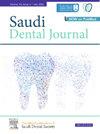Enhancing predictive analytics in mandibular third molar extraction using artificial intelligence: A CBCT-Based study
IF 2.3
Q3 DENTISTRY, ORAL SURGERY & MEDICINE
引用次数: 0
Abstract
Objective
Forecasting the complexity of extracting mandibular third molars is crucial for selecting appropriate surgical methods and minimizing postoperative complications. This study aims to develop an AI-driven predictive model using CBCT reports, focusing specifically on predicting the difficulty of mandibular third molar extraction.
Methods
We conducted a retrospective study involving 738 CBCT reports of mandibular third molars. The data was divided into a training set consisting of 556 reports and a validation set containing 182 reports. The study involved two main steps: pre-processing and processing of the textual data. During pre-processing, the reports were cleaned and standardized. In the processing phase, a rule-based NLP algorithm was employed to identify relevant features such as angulation, number of roots, root curvature, and root-nerve canal relationship. These features were utilized for the training of a deep learning neural network to classify the extraction difficulty into four categories: easy, slightly difficult, moderately difficult, and very difficult.
Results
The classification model achieved an accuracy of 95% in both the training and validation sets. Precision, recall, and F1-score metrics were calculated, yielding promising results with precision and recall values of 0.97 and 0.95 for the training set, and 0.97 and 0.89 for the validation set, respectively.
Conclusion
The study demonstrated the high reliability of AI-based models to forecast the complexity of the mandibular third molar extractions from CBCT reports. The results indicate that AI-driven models can accurately predict extraction difficulty, thereby aiding clinicians in making informed decisions and potentially improving patient outcomes.
使用人工智能增强下颌第三磨牙拔牙的预测分析:一项基于cbct的研究
目的预测下颌第三磨牙拔除的复杂程度,对选择合适的手术方法和减少术后并发症具有重要意义。本研究旨在利用CBCT报告开发人工智能驱动的预测模型,重点预测下颌第三磨牙拔牙的难度。方法对738例下颌第三磨牙的CBCT报告进行回顾性研究。数据被分为包含556个报告的训练集和包含182个报告的验证集。该研究包括两个主要步骤:预处理和文本数据的处理。在预处理过程中,报告被清理和标准化。在处理阶段,采用基于规则的NLP算法识别相关特征,如成角、根数、根曲率、根-神经管关系等。利用这些特征对深度学习神经网络进行训练,将提取难度分为简单、略难、中等困难和非常困难四类。结果该分类模型在训练集和验证集的准确率均达到95%。计算了准确率、召回率和f1得分指标,得到了很好的结果,训练集的准确率和召回率分别为0.97和0.95,验证集的准确率和召回率分别为0.97和0.89。结论基于人工智能的下颌第三磨牙拔除复杂性预测模型具有较高的可靠性。结果表明,人工智能驱动的模型可以准确预测拔牙难度,从而帮助临床医生做出明智的决策,并有可能改善患者的治疗效果。
本文章由计算机程序翻译,如有差异,请以英文原文为准。
求助全文
约1分钟内获得全文
求助全文
来源期刊

Saudi Dental Journal
DENTISTRY, ORAL SURGERY & MEDICINE-
CiteScore
3.60
自引率
0.00%
发文量
86
审稿时长
22 weeks
期刊介绍:
Saudi Dental Journal is an English language, peer-reviewed scholarly publication in the area of dentistry. Saudi Dental Journal publishes original research and reviews on, but not limited to: • dental disease • clinical trials • dental equipment • new and experimental techniques • epidemiology and oral health • restorative dentistry • periodontology • endodontology • prosthodontics • paediatric dentistry • orthodontics and dental education Saudi Dental Journal is the official publication of the Saudi Dental Society and is published by King Saud University in collaboration with Elsevier and is edited by an international group of eminent researchers.
 求助内容:
求助内容: 应助结果提醒方式:
应助结果提醒方式:


